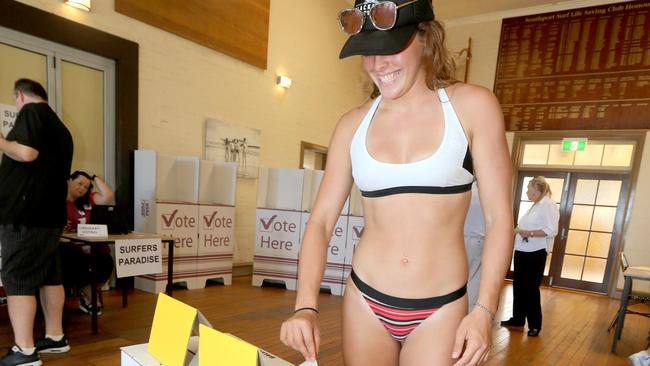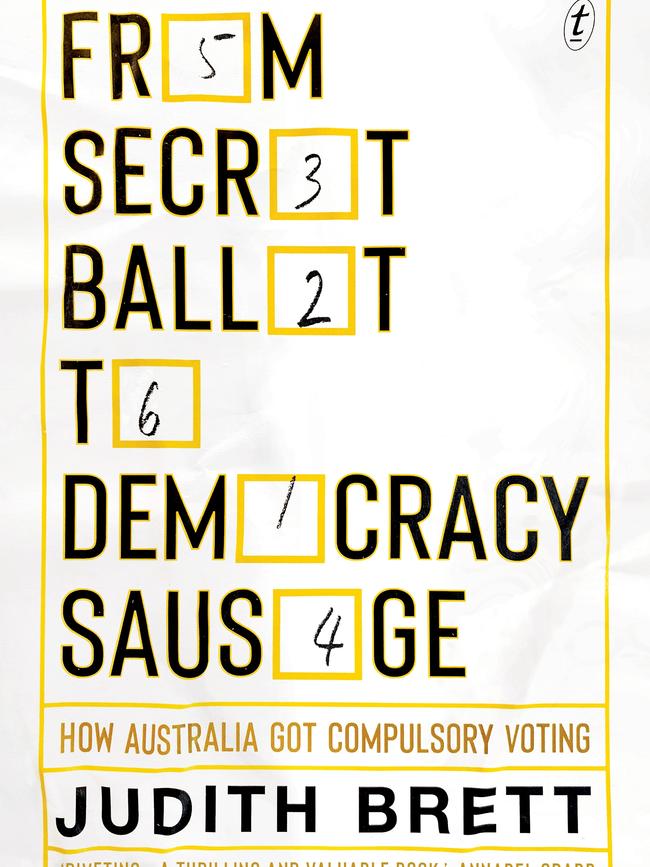How Australia changed democracy
Australia has a proud place in the history of democracy, especially the acceptance of compulsory voting.

There is a wonderful moment early in Judith Brett’s magnificent From Secret Ballot to Democracy Sausage: How Australia Got Compulsory Voting. The year is 1843 and Australia’s first parliamentary election is being held in the colony of NSW (which included what is now Victoria). Following how elections were conducted in Britain, voting was done openly, usually outside of pubs. The following occurred:
Australia’s first election day ended in violence and riots, including in Sydney and Melbourne. Police and soldiers struggled to control drunken mobs armed with staves and pickets who tore down banners, demolished campaign booths, and smashed the doors and windows of nearby shops and houses. Two men were killed, one in Sydney and one in a country district, and many injured. Irishmen were prominent among the rioters, giving the violence a sectarian edge, but alcohol and the attractions of mayhem were the main causes. There was nothing unusual in this by English precedent and Governor George Gipps reported back to London that ‘‘The Election in general went off very well’’.
From such rough beginnings emerged Australia’s voting system. Brett has constructed an excellent, fast-moving narrative establishing how Australia became one of the world’s pre-eminent democracies. Despite hailing from the sometimes dusty halls of academia, Brett skilfully weaves her way through what would be in the hands of a lesser writer a dull, dry topic.

Mayhem and drunken Irishmen aside, Australia’s democracy in the 19th and early 20th-century was already a “laboratory for new ideas about democracy, and new methods of achieving them”.
Nowhere was this more apparent than in the implementation of the secret ballot, which would become known for the rest of the 19th century as “the Australian ballot” as other nations introduced it into their electoral systems.
While it is a core part of the democratic process, and taken for granted today, it is fascinating to read about the objections across the English-speaking world at the time. In one sense, a secret ballot was seen to be “Un-English, not the forthright conduct expected of the sons of John Bull. Secrecy was for women.”
Concerns one’s masculinity might be threatened by engaging in a secret ballot intersected with religion, as Brett notes: “The manly English character displayed in open voting was a Protestant construct, hostile to the secrecy of the Catholic confessional and the feminine dependence of Catholics on their priests.”
Thankfully, Australian men proved confident enough in their masculinity and Protestantism to accept the idea of the secret ballot. Other groups had longer struggles. While Australia stands rightfully alongside New Zealand as one of the first nations to give women both the vote and the right to stand for public office, it was a fight that lasted decades.
Brett introduces the reader to towering historical figures who assisted in the process such as Mary Lee, who campaigned in South Australia for the right of women to vote, and Catherine Helen Spence, who modified the political innovations of British political reformer Thomas Hare into preferential voting.
But the struggle for female suffrage also intersected with contemporary views on race. In one of the more startling visuals in the book, readers are able to view the October 1900 cover of The Australian Woman’s Sphere, an early periodical arguing for the female vote.
In the centre of the cover we see a white woman, reading a book, stating “But I may not be trusted with a vote.” Surrounding her are pictures of men in various states of disgrace, all of whom have the vote. Most egregious, at least for this magazine, are the men to either side of the women: a drunken Aboriginal and an opium smoking Chinese man. Both have the vote.
In Australia, like other fledgling democracies, the right to vote was inextricably caught up in questions of race. For indigenous Australians, these rights were granted and taken away at several points as Australia crossed from being a collection of colonies to an independent nation. Brett describes this process as a “complicated and shameful story”. It was one that would not be fully resolved until the 1960s.
But it is how we manage our elections that demonstrates why Australia is one of the world’s greatest democracies. In truth, compulsory voting is almost unknown in other parts of the world. Only 19 out of the world’s 166 democracies have compulsory voting, and only nine strictly enforce it. We are the only English-speaking democracy that has it.
Many consider enforcing the vote this way in a democracy as “an affront to freedom”. And yet it has been a key part of our democratic story since the 19th century.
Brett is too skilled a writer to allow her work to descend into jingoism, but the reader does feel a swelling sense of pride as she observes that “compulsory voting became normal — as Australian as voting in speedos or a bikini”.
It is compulsory voting that has prevented Australia from becoming the democratic basket case that the US, with its lack of a centralised electoral commission, hours-long waits to vote, and compromised franchise, is when it comes to managing elections.
It has also, for the most part, allowed the political conversation in this country to keep returning to the sensible centre, rather than encouraging politicians pandering to the extremes in an attempt to “get out the vote”.
Election days themselves are a civic joy as we make the most important of democratic decisions in a carnival-like atmosphere of school fundraisers, brightly coloured posters and the now ubiquitous democracy sausage from which Brett takes her title.
Brett does not end on a completely triumphalist note, however. Arguments have resurfaced against compulsory voting and various political blowhards have engaged in US-imported accusation and innuendo around electoral fraud and the need for ID checks. And regardless of where one sits on the political spectrum, the spectacle of both major parties engaging in Game of Thrones-style leadership coups has been dispiriting and disappointing.
As her final chapter title states bluntly, however, “We Are Good At Elections”. As Australia moves ever further into the 21st century and we seek new ways to imagine ourselves as a nation, Brett is right to point out that we need “more than the Anzac story” to understand our success. From Secret Ballot to Democracy Sausage: How Australia Got Compulsory Voting will be an important part of that conversation.
Andrew Broertjes teaches history at the University of Western Australia.
From Secret Ballot to Democracy Sausage: How Australia Got Compulsory Voting
By Judith Brett. Text Publishing, 208pp, $29.99



To join the conversation, please log in. Don't have an account? Register
Join the conversation, you are commenting as Logout